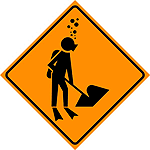|
| |

|
|
| < Prev. month |
Next month > |

|
This page under construction.
Here are some of the topics that will be covered in this chapter. More text and images will eventually be added to this section. Thank you for your patience.
|
- The kelp canopy becomes almost continuous, even in exposed areas, blocking light to understory algae.
- The giant kelp canopy begins to grow more slowly because of self-shading and infestations of grazers, encrusting sponges, bryozoans, and other algae.
- Annual kelps such as bull kelp and oar weed reach maximum length.
- Populations of predatory Callistoma spp. snails peak in kelp beds, feeding on tunicates, hydroids, and algae that have colonized the kelp.
- Spring-spawning rockfish (including kelp rockfish, gopher rockfish, and black-and-yellow rockfish) end their planktonic life phase and enter the kelp beds in large numbers, feeding on snails and other small animals of the kelp community, whose populations peak at this time of year.
- Juvenile lingcod settle out and enter kelp beds, feeding on small fish (including other lingcod) squid, octopi, and crabs.

|
|
